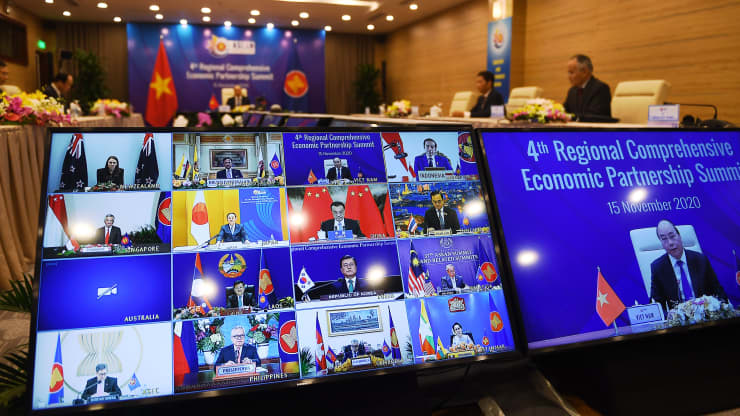SINGAPORE — China and 14 other Asia-Pacific countries signed the world’s largest trade agreement on Sunday — a move that analysts said will further elevate China’s political and economic influence in the region.
The signing cemented the Regional Comprehensive Economic Partnership (RCEP) as the largest trading bloc globally, covering a market of 2.2 billion people and $26.2 trillion of global output. That accounts for about 30% of the population worldwide, as well as the global economy. It is also larger than what’s covered under the United States-Mexico-Canada Agreement (USMCA) and the European Union.
The diplomatic messaging of RCEP may be just as important as the economics — a coup for China.Citi Research
Analysts said economic benefits of RCEP are modest and would take years to materialize. But the deal is a geopolitical victory for China at a time when the U.S. appears to be retreating from Asia-Pacific given President Donald Trump’s “America First” foreign policy, they added.
It’s also not clear whether the U.S. will negotiate any mega trade deals with economies in the region under President-elect Joe Biden, the analysts said.
The 10-member Association of Southeast Asian Nations signed the mega deal with the region’s top trading partners China, Japan, South Korea, Australia and New Zealand. ASEAN is made up of Indonesia, Thailand, Singapore, Malaysia, the Philippines, Vietnam, Brunei, Cambodia, Myanmar — formerly Burma, and Laos.
“The diplomatic messaging of RCEP may be just as important as the economics — a coup for China,” analysts from Citi Research wrote in a Sunday report.
They explained that the mega deal achieves several things against the backdrop of rising U.S.-China tensions and worries about de-globalization:
- Shows that East Asia is very much open for business and recognizes the economic benefits of deeper trade integration.
- Reduces the perception that China is turning more inward with its “dual circulation strategy,” which emphasizes its domestic market.
- Signals that when it comes to economic policy, Asia-Pacific economies don’t want to choose between the U.S. and China. That’s true even for countries with strong security alliances with the U.S., such as Japan and South Korea.
RCEP benefits
RCEP was launched in November 2012 at a time when talks for another major trade pact, the Trans-Pacific Partnership (TPP) led by the Obama administration, were underway.
Given China’s absence in the TPP, many observers considered RCEP as Beijing’s counter to American influence in Asia-Pacific — even though RCEP negotiations were led by ASEAN.
But Trump pulled the U.S. out of the TPP in 2017 and proceeded to slap punitive tariffs on several American trading partners for what he said were unfair trade practices. The remaining 11 countries in the TPP went on to renegotiate the pact and signed the Comprehensive and Progressive Agreement for Trans-Pacific Partnership (CPTPP) in 2018.
Analysts said RCEP is a weaker trade deal compared to the CPTPP. Tariffs among many RCEP member countries are already low given existing bilateral or smaller multilateral trade deals among them, so the direct economic benefits are limited, they said.
For example, more than 70% of trade among the 10 ASEAN countries are conducted with zero tariffs, noted Gareth Leather, senior Asia economist at consultancy Capital Economics.
Additional tariff reductions under RCEP “will only come into force gradually, and it will be years before the treaty is fully operational,” Leather said in a report on Thursday.
But the mega deal lays the foundation for deeper cooperation among member countries in the future, especially between those that don’t have existing bilateral trade deals, said Simon Baptist, global chief economist at consultancy The Economist Intelligence Unit.
Possible bilateral “pairings” include China and Japan, the world’s second- and third-largest economies, as well as Japan and South Korea, which are entangled in a bilateral trade dispute, Baptist told CNBC’s “Squawk Box Asia” on Monday.
“While at the moment the amount of liberalization that’s going to happen is going to be pretty limited, it does now mean that this framework is in place so that in the future there will be opportunity to build on this should attitude towards trade, or should bilateral relations move in the right direction,” he said.
Will India return?
India, which was involved in RCEP negotiations from the start, pulled out of the pact last year. Among the country’s concerns are that the deal would result in a flood of cheap Chinese imports that would hurt Indian manufacturers.
The RCEP deal signed over the weekend has kept the door open for a potential return by India. Some member countries, such as Japan, considered India’s presence important to counter China’s economic weight, said Leather of Capital Economics.
But “clashes in the Himalayas since then make signing a deal that involves China even harder,” Leather said. He was referring to skirmishes over the India-China border that reportedly killed at least 20 Indian soldiers and at least 40 Chinese solders.
Analysts from Citi Research said India is one of the biggest losers from RCEP. Citing an analysis from think tank Peterson Institute for International Economics, Citi said India could have gained 1.1 percentage points in real GDP by 2030 had it stayed in the pact.
“But its exclusion will likely make India less attractive as an alternative production base versus ASEAN,” the Citi analysts said.
Even if India doesn’t return to the deal, the current 15 RCEP participating economies will grow to account for 50% of global output by 2030, according to a HSBC report on Sunday.
“From a global perspective, the RCEP agreement, even if a littler shallower than other ‘mega-deals’, signals that Asia keeps pushing ahead with trade liberalization even as other regions have become more sceptical,” HSBC economists said.
“As such, it may reinforce a trend that’s been already underway for decades: that the global centre of economic gravity keeps pushing relentlessly to the East.”















